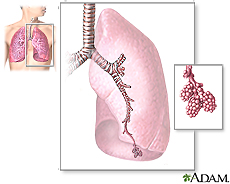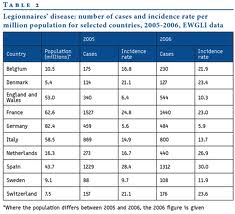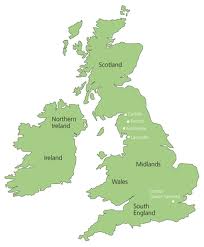Legionnaire's Disease: Difference between revisions
No edit summary |
No edit summary |
||
| Line 11: | Line 11: | ||
==Definition/Description== | ==Definition/Description== | ||
Legionnaires' Disease is a deadly severe form of [[pneumonia]]. It cab be a cause of [[Hospital Acquired Pneumonia|hospital acquired pneumonia]]. Legionnaires' disease is a lung infection that can be fatal. It is a disease caused by a bacteria, known as ''Legionella''. This disease is often screened for whenever a person is diagnosed with pneumonia because of the close resemblance Legionnaires' has to pneumonia. Legionnaires' disease is commonly acquired from inhaling the bacteria. [[Image:Lunganatomy.jpg|frame|Legionnaire's Disease]] The history of Legionnaires' Disease can be viewed below under ''History of Disease''. | |||
<br>The bacteria, ''Legionella'', in | <br>The bacteria, ''Legionella'', in Legionnaires' disease can also lead to Pontiac Fever, which is like a milder version of Legionnaires' disease. Pontiac Fever resembles a mild and self-resolving flu-like disease.<ref name=":0">Sharma L, Losier A, Tolbert T, Dela Cruz CS, Marion CR. Atypical Pneumonia: Updates on Legionella, Chlamydophila, and Mycoplasma Pneumonia. ''Clin Chest Med''. 2017;38(1):45–58. doi:10.1016/j.ccm.2016.11.011 retrieved from https://www.ncbi.nlm.nih.gov/pmc/articles/PMC5679202/</ref> If a person is diagnosed with both illnesses, then the term is Legionellosis. Unlike Legionnaires' disease, Pontiac Fever usually resolves on its own after 2-5 days.<ref name=":0" /> | ||
[[Image:Ld image.jpg|Image:Ld_image.jpg]] | [[Image:Ld image.jpg|Image:Ld_image.jpg]] | ||
<br>'''<u>History of Disease</u>''': | <br>'''<u>History of Disease</u>''': Legionnaires' disease first came about in 1967 when a group of people in Philadelphia, attending an American Legion convention meeting became exposed to this disease. View ''Legionnaire's Disease ''video below or please visit http://www.youtube.com/watch?v=8oTf2bGCt-Y<nowiki/>. | ||
{{#ev:youtube|8oTf2bGCt-Y|300}} | {{#ev:youtube|8oTf2bGCt-Y|300}} | ||
Revision as of 04:07, 21 March 2020
Original Editors - Itayi Charasika from Bellarmine University's Pathophysiology of Complex Patient Problems project.
Top Contributors - Itayi Charasika, Donald John Auson, Kim Jackson, Kalyani Yajnanarayan, Admin, Elaine Lonnemann, WikiSysop, Nupur Smit Shah and Adam Vallely Farrell
This article is currently under review and may not be up to date. Please come back soon to see the finished work! (21/03/2020)
Definition/Description[edit | edit source]
Legionnaires' Disease is a deadly severe form of pneumonia. It cab be a cause of hospital acquired pneumonia. Legionnaires' disease is a lung infection that can be fatal. It is a disease caused by a bacteria, known as Legionella. This disease is often screened for whenever a person is diagnosed with pneumonia because of the close resemblance Legionnaires' has to pneumonia. Legionnaires' disease is commonly acquired from inhaling the bacteria.
The history of Legionnaires' Disease can be viewed below under History of Disease.
The bacteria, Legionella, in Legionnaires' disease can also lead to Pontiac Fever, which is like a milder version of Legionnaires' disease. Pontiac Fever resembles a mild and self-resolving flu-like disease.[1] If a person is diagnosed with both illnesses, then the term is Legionellosis. Unlike Legionnaires' disease, Pontiac Fever usually resolves on its own after 2-5 days.[1]
History of Disease: Legionnaires' disease first came about in 1967 when a group of people in Philadelphia, attending an American Legion convention meeting became exposed to this disease. View Legionnaire's Disease video below or please visit http://www.youtube.com/watch?v=8oTf2bGCt-Y.
Prevalence[edit | edit source]
Accurate data reflecting the true incidence of disease are not available because of underutilization of diagnostic testing and under-reporting. It is a common cause of severe pneumonia requiring hospitalization10.
Facts:
- Responsible for ~ 5% of all pneumonias4
- 12,000 people affected yearly in the U.S.4
- Severe, sometimes fatal disease4
- Each year an estimated 8,000-18,000 hospitalized cases occur in the U.S.10
- The majority of reported cases are sporadic10
- Travel-associated outbreaks, outbreaks in community settings, and nosocomial and occupational outbreaks are common10
- More than 20% of all cases are thought to be associated with recent travel10
- Difficult to detect among travelers because of the low attack rate, long incubation period, and the dispersal of persons from the source of the outbreak10
- Present rate is that 80% of those contracting the disease die26
For recent breaking news on Legionnaire's Disease regarding California health officials investigating a mystery illness at the Playboy mansion possibly caused by a fog machine, please visit http://www.youtube.com/watch?v=xk5dEOYtPbw&feature=fvsr.
♦ Legionnaire's Disease is not only found in the United States, but it is worldwide. ♦
Characteristics/Clinical Presentation[edit | edit source]
For patient stories on contracting Legionnaire's Disease, visit http://www.youtube.com/watch?v=n5tL69KVTZg.
Many patients report having the following symptoms: 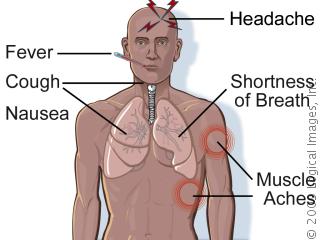
♦ S/S: Fevers, chills, dry or productive cough, fatigue, anorexia, headache, myalgia, diarrhea, muscle aches, & gastrointestinal symptoms4
Associated Co-morbidities[edit | edit source]
People at risk:
- Smokers (esp. Middle-aged/older adults who smoke cigarettes)
- Chronic lung disease
- Advanced age
- Alcohol abuse
- Surgery
- Recent travel with an overnight stay outside of the home
- Exposure to whirlpool spas
- Recent repairs or maintenance work on domestic plumb
- Immune system compromised by
o DM
o Renal Failure
o Cancer (esp. hematological or pulmonary malignancy)
o AIDS
Medications[edit | edit source]
► Erythromycin (the drug of choice for prolonged period) - given early
► Rifampin is also a benefit
Newer Effective Therapeutic Options Include Antibiotics (Macrolides)4:
► Clarithromycin
Diagnostic Tests/Lab Tests/Lab Values[edit | edit source]
Legionnaire’s disease is diagnosed by growing bacteria on a special medium and silver staining. The bacteria is identified in the sputum and the Legionella antigen is seen in the urine4.
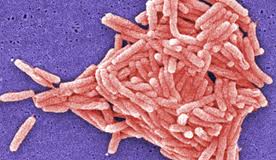
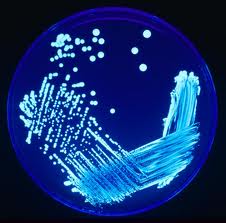
What diagnostic tests can confirm Legionnaires' disease? (http://www.cdc.gov/legionella/faq.htm9)
|
Test |
Advantages |
Disadvantages |
| Culture | - Clinical & Environmental isolates can be compared - Detects all species & serogroups - 100% specific |
- Technically difficult - Slow (>5 days to grow) - Sensitivity highly dependent on technical skill - May be affected by antibiotic treatment |
| Urine Antigen | - >99% specific... - Rapid (same day) |
- ...but only for L. pneumophila serogroup 1 (Lp1) [ which may account for up to 80% of cases] - Limited utility when compared to environmental isolates |
| Serology | - Not affected by antibiotic treatment - 70-80% sensitive; >90% specific |
- Must have paired sera - 5-10% of population has titer 1:≥256 Single acute phase antibody titers of 1:≥256 do not discriminate between cases of Legionnaires' disease and other causes of community-acquired pneumonia. |
| DFA | - Can be performed on pathologic specimens - 95% specific |
- 25-75% sensitive |
Etiology/Causes[edit | edit source]
Legionnaire’s disease is the cause of nosocomial pneumonia4.
Common places that allow Legionella transmission10:
1. Potable (drinking) water systems
2. Whirlpool spas
3. Cooling towers
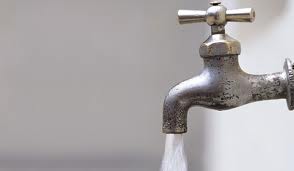
Conditions for Legionella transmission10:
1. Heat
2. Stasis
3. Aerosolization
Systemic Involvement[edit | edit source]
► Gastrointestinal symptoms include nausea, vomiting, diarrhea, and anorexia.
► Neurologic symptoms include headache, lethargy, altered mental status, and rarely, focal symptoms.
► Musculoskeletal symptoms include arthralgias and myalgias.
► Nonpulmonary symptoms are prominent early in the disease.
Medical Management (current best evidence)[edit | edit source]
Patients diagnosed with Legionnaire's Disease are prescribed to take the various medications see above under Medications.
For patients with Pontiac fever: it is a self-limited illness that does not benefit from antibiotic treatment. Complete recovery usually occurs within 1 week10.
Physical Therapy Management (current best evidence)[edit | edit source]
► Screening Questions:
- Have you traveled recently? (Patient could have traveled-associated Legionnaire’s disease (http://www.cdc.gov/legionella/faq.htm9)
► Top 10 Things Every Clinician Needs to Know About Legionellosis (http://www.cdc.gov/legionella/top10.htm10)
What does the diagnosis of Legionnaire’s disease include? Two clinical syndromes:
| Legionnaires' disease | Pontiac fever | |
| Clinical Features | Pneumonia: cough, fever, chest pain | Flu-like illness (fever, chills, malaise) without pneumonia |
| Radiographic pneumonia | Yes | No |
| Incubation period | 2-14 days after exposure | 24-48 hours after exposure |
| Etiologic agent | Legionella species | Legionella species |
| Attack rate* | < 5% | > 90% |
| Isolation of organism | Possible | Virtually never |
| Outcome | Hospitalization common Case-fatality rate: 5-40%** |
Hospitalization uncommon Case-fatality rate: 0% |
| Additional Below* |
* Percent of persons who, when exposed to the source of an outbreak, become ill.
** Percent of persons who die from Legionnaires' disease or Pontiac fever.
| Test | Sensitivity (%) | Specificity (%) |
| Culture | 80 | 100 |
| Urine antigen | 70 | 100 |
| Paired serology* | 70-80 | >90 |
| Direct fluorescent antibody stain | 25-75% | 95 |
| *Note: A single antibody titer of any level is not diagnostic of legionellosis |
► Patient Care: Respiratory Therapists/PTs: O2 therapy, repositioning, postural drainage, suctioning4
► Monitor: Chest wall expansion, depth/pattern of ventilations, cough, chest pain, restlessness, & hypoxemia4
► Signs of Shock: ↓ blood pressure, tachycardia w/weak thread pulse, diaphoresis, clamy skin, & cold4
► Patient Education: Pulmonary hygiene, deep breathing and coughing exercises, chest physiotherapy, postural drainage, disposal of solid tissues to prevent disease transmission4
Alternative/Holistic Management (current best evidence)[edit | edit source]
Treatment: Natural Encyclopedia recommends following remedies for Pnuemonia & Bronchitis.
•You will want to use essentially the same treatment as outlined for bronchitis; except that, because the person's illness is so much more serious, he must be given much rest and intensified care.
•Rinse out the nose with saltwater, gently taking it in and blowing it out. Gargle with saltwater. Then repeat the rinsing and gargling with a goldenseal and myrrh mixture. This will help keep a cold or flu from going down into the lungs.
•But if the lungs are already affected, do the above treatment. Also give hot footbaths and a high herb enema at least once a day. Drink plenty of water. Take laxative herbs, to keep the bowels working properly. Give short, hot fomentations to the chest and upper back, with short cold between each hot application.
•Only give liquids the first few days. These should consist of fruit juices (diluted pineapple juice or orange juice) or lemon and water (without sugar), etc. Continue this until the high fever abates. Then give strained vegetable broths, whole grains (best in dry form, so it will be chewed well). •
•Stop smoking and get tobacco out of the house. If you have chronic bronchitis, do not expect much improvement as long as tobacco smoke is in the home.
•Do not use milk; it produces a thick phlegm which complicates healing. White-flour products and sugar foods should not be used until bronchitis is past.
•Drink plenty of fluids: pure water, soups, and herb teas. Vitamin C is important! Take it to bowel tolerance.
•Anise tea and almond milk are helpful in bronchitis. Make the almond milk by blending 6 tbsp. of almonds in a pint of water.
•Cayenne and lobelia will help break up the congestion.
•Add moisture to the air with a vaporizer or humidifier or heat a pan of water on the stove.
•Remain in bed as long as fever is present. Bronchitis often hangs on because people think it is about over and begin going about their everyday duties. Go to bed and get well.
•Deep breathing exercises should be taken 3-4 times a day. Take a deep breath, hold it a few seconds, and exhale. Do this 10-20 times. This will help air out of the infected area.
•Breathe deep. Blow up a balloon several times every day. This helps open up and enlarge the airways.
•Apply a heating compress at night.
•A hot footbath will help pull the blood away from the chest and reduce congestion.
•Hot drinks help you cough out the phlegm. Coughing is the only way the phlegm can come out. Do not use cough suppressants while you have bronchitis.
•Apply warm, moist heat or a hot water bottle over the chest and back before bedtime. This will help relieve congestion and aid in sleep.
•Avoid fatigue and chilling. Do not walk barefoot on cold floors while you are trying to get well.
•If the coughing gets worse, there is a high fever, wheezing sounds, lethargy, and weakness. Chest pains develop and very difficult breathing. Contact a health professional; the condition may be developing into pneumonia.
•If the condition persists over too long a time, there is the possibility of tuberculosis or lung cancer.
•A professional can use bronchoscopy instruments to examine the bronchial tubes and suction out phlegm.
•In recent years, a new type of bronchitis has arisen, which is contracted primarily by women. Difficult to treat, it often continues for 3 weeks to 5 months. Drinking goldenseal tea is helpful with this condition, as well as with other types of bronchitis.
•Other helpful herbs include pau d'arco, chickweed, ginkgo biloba, burdock, lobelia, slippery elm bark, echinacea, and wild cherry bark.
Data taken from Natural Encyclopedia26.
Differential Diagnosis25[edit | edit source]
- Adult Respiratory Distress Syndrome (ARDS)
- Bronchitis
- Congestive heart failure
- Gastroenteritis
- HIV infection and AIDS
- Inflammation of the rib cartilage (costochondritis)
- Meningitis
- Non-Legionnaire's pneumonia
- Pleural effusion
- Pneumonia caused by other organisms
- Prostatitis
- Septic shock
- Tuberculosis
Case Reports/ Case Studies[edit | edit source]
•Atypical Presentation of Legionnaire’s Disease: A Case Report and Review
•Severe Legionnaires disease complicated by multi-organ dysfunction in a previously healthy patient: a case report [7]
•Legionnaires Disease: A Case Study
Resources[edit | edit source]
1.http://www.cdc.gov/legionella/patient_facts.htm 2. http://www.osha.gov/SLTC/legionnairesdisease/index.html 3. OSHA eTool: http://www.osha.gov/dts/osta/otm/legionnaires/index.html 4. Taber’s Cyclopedic Medical Dictionary. F.A. Davis Company. Phildelphia. Edition 19. 2001. Pg.121 5. Atypical Presentation of Legionnaire’s Disease: A Case Report and Review. Sophie Kay1, DO, Christopher Grantham2, MD, Michelle Dahdouh3, MD. http://newyorkmedicaljournal.org/index.php/articles/atypical_presentation_of_legionnaires_disease_a_case_report_and_review 6. Legionnaires Disease: A Case Study. By Melinda Cramer, RN, BSN. From School of Nursing, University of Pennsylvania, Philadelphia, Pa. American Journal of Critical Care. 2003;12: 234-238. http://ajcc.aacnjournals.org/content/12/3/234.full 7. Severe Legionnaires disease complicated by multi-organ dysfunction in a previously healthy patient: a case report. Kays Kassha1, Issam Abuanza2, Samer A Hadi3 and Roy Hilton2. http://casesjournal.com/content/2/1/9151 8. Legionnaires' Disease with Facial Nerve Palsy. Case Reports in Medicine. Volume 2011 (2011), Article ID 916859, 4 pgs. Shailesh R. Basani, Salwa Mohamed Ahmed, and Eyassu Habte-Gabr. Received 20 September 2010; Accepted 16 January 2011. http://www.hindawi.com/journals/crim/2011/916859/ 9. http://www.cdc.gov/legionella/faq.htm
10. http://www.cdc.gov/legionella/top10.htm
References[edit | edit source]
- ↑ 1.0 1.1 Sharma L, Losier A, Tolbert T, Dela Cruz CS, Marion CR. Atypical Pneumonia: Updates on Legionella, Chlamydophila, and Mycoplasma Pneumonia. Clin Chest Med. 2017;38(1):45–58. doi:10.1016/j.ccm.2016.11.011 retrieved from https://www.ncbi.nlm.nih.gov/pmc/articles/PMC5679202/
17. http://www.suntimes.com/news/nation/4080689-418/legionnaires-disease-found-at-playboy-mansion.html
18. http://www.nbcchicago.com/news/local/Bacteria-that-Causes-Legionnaires-Disease-Found-at-Playboy-Mansion-117204503.html
19. http://www.dailymail.co.uk/news/article-1361964/Playboy-Mansion-illness-Legionnaires-disease-bacteria-water-source.html
20. http://www.mayoclinic.com/health/legionnaires-disease/DS00853
21.http://www.nlm.nih.gov/medlineplus/legionnairesdisease.html & picture
22. http://www.nlm.nih.gov/medlineplus/ency/article/000616.htm
23. http://www.legionella.org/
24. http://emedicine.medscape.com/article/783656-overview
25. http://www.mdguidelines.com/legionnaires-disease/differential-diagnosis
26. http://www.naturalencyclopedia.com/Legionnaire's_Disease
